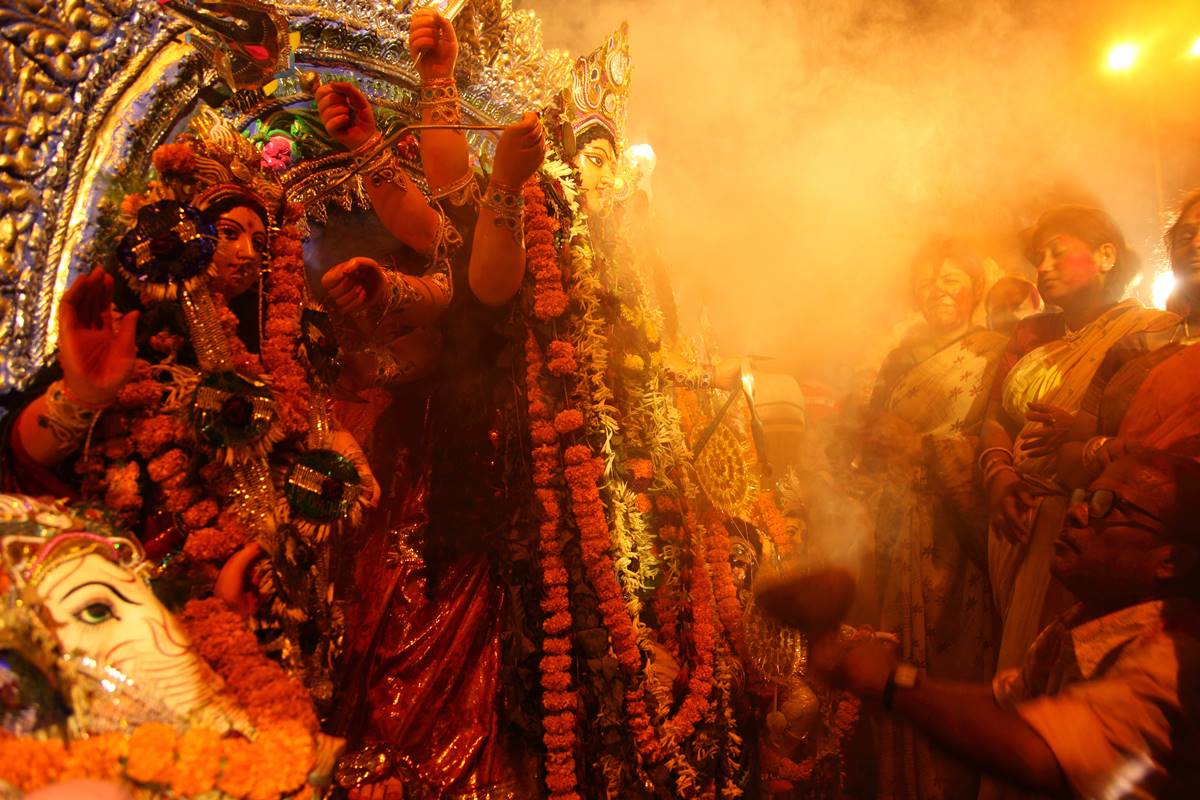VBU hikes entry fee for visitors at Shantiniketan
The Visva-Bharati University (VBU) authority has increased the entry fees for Upasana Griha and Rabindra Bhawan and the surrounding areas.
Kolkata Durga Puja is India’s official nomination for UNESCO’s 2020 Representative List of Intangible Cultural Heritage of Humanity, according to Sangeet Natak Akademi

During Durga Puja festivities in Kolkata. (Photo: Getty Images)
If everything goes as planned, the Durga Puja of Kolkata may finally get the UNESCO World Heritage status next year. Kolkata Durga Puja is India’s official nomination for UNESCO’s 2020 Representative List of Intangible Cultural Heritage of Humanity.
Sangeet Natak Akademi, under the Union Ministry of Culture is the nodal agency that sends recommendations for cultural institutions in India that need protection and preservation. According to the Akademi website, Durga Puja, a “conglomeration of different cultures”, is India’s choice for the 2020 update of UNESCO cultural heritage list.
UNESCO has a growing Representative List of the Intangible Cultural Heritage of Humanity as it keeps adding entries from across the world to it every year.
Advertisement
Quoting Professor Tapati Guha Thakuta, who led a five-member research team prepare the nomination dossier for the Sangeet Natak Akademi, a report in Hindustan Times said: “Kolkata’s Durga Puja has developed a special artistic profile, which no other festival has with modern artists and designers coming together to produce a new urban art. This gives it a unique dimension.”
Applying for the World Heritage status, the SNA has said in the nomination form: “…Durga Puja, unlike many other regional religious festivals of India, has a thriving global identity. Through this inscription, the already growing international face of Durga Puja will find a new order of legitimacy and artistic creativity, adding to the multi-cultural dimensions of the event and encouraging Bengali communities overseas to sustain the collective vigour and cultural fervor of the celebrations.”
It also said the inscription would serve to “bring into a common platform of interest all the organizational units of Durga Puja”; “bring into productive dialogue the growing community of Puja designers and artists with the
corporate sponsors and organisers of community Pujas”; and “bring into participatory dialogue the regional, national, and international organising units of Durga Puja”.
Durga Puja has always been a cumulative effort of several groups of people. The Sangeet Natak Akademi collected as many as 179 letters of consent from the representatives of such groups before it prepared the nomination dossier. These groups are classified into six categories — government; Durga Puja organisers; idol makers, artists, designers and priests; mediapersons and corporate sponsors; scholars; and other supporting institutions.
Explaining the festival and its importance, the dossier describes Kolkata Durga Puja as the “best instance of the public performance of religion and art”. Calling it a celebration of craftsmanship, cross-cultural transactions and cross-community revelry, the SNA report says, “The exemplary character of Durga Puja lies in its ability to not temporally bound itself to the ritual occasion. Its dynamism lies in it being a constantly mutating event – in its fusion of tradition with changing tastes and popular cultures, and in the adaptation of the iconographies of Durga and the styles of her temporary abodes to cater to new regimes of art production.”
It has been long since the demand for recognition of festivals like the Durga Puja as the living cultural heritage has been put forth to ensure they are protected as intangible assets of cultural heritage. Durga Puja in West Bengal was recommended for inclusion in the ICH list in the beginning of this decade, and it has been on the backlog list since 2012 along with 22 other entries, some of them from 2010. The UNESCO’s ICH portal says these files have not been treated due to the limited capacities of the committee, its bodies and the Secretariat.
The other entries from India in the backlog list include Dashavatar, a traditional folk theatre form Maharashtra and Goa; the Lama dances of Sikkim; Nacha folk theatre of Chhattisgarh; Patola silk textiles of Gujarat; Phad scroll paintings and their narration from Rajasthan; shadow puppet theatre traditions; Chaar Bayt, a Muslim tradition in lyrical oral poetry; Kalamkari paintings; Nautanki; Practice of turban tying in Rajasthan; and Qawwali among others.
India already has 13 Intangible Cultural Heritage elements inscribed on the UNESCO representative list.
Nominated in 2019, Sowa-Rigpa, the Tibetan system of medicine, is on the ongoing nomination list from India for ICH status. Similar to Ayurveda, Sowa-Rigpa is a well documented medical tradition that originated from Tibet and is popular in India, Nepal, Bhutan, Mongolia and Russia.
Tradition of Vedic chanting (2008)
Ramlila (2008)
Kutiyattam, Sanskrit theatre (2008)
Ramman, religious festival and ritual theatre of the Garhwal (2009)
Mudiyettu, ritual theatre and dance drama of Kerala (2010)
Kalbelia folk songs and dances of Rajasthan (2010)
Chhau dance (2010)
Buddhist chanting of Ladakh (2012)
Sankirtana, ritual singing, drumming and dancing of Manipur (2013)
Traditional brass and copper craft of utensil making among the Thatheras of Jandiala Guru, Punjab, India (2014)
Yoga (2016)
Nawrouz (2016)
Kumbh Mela (2017)
Advertisement